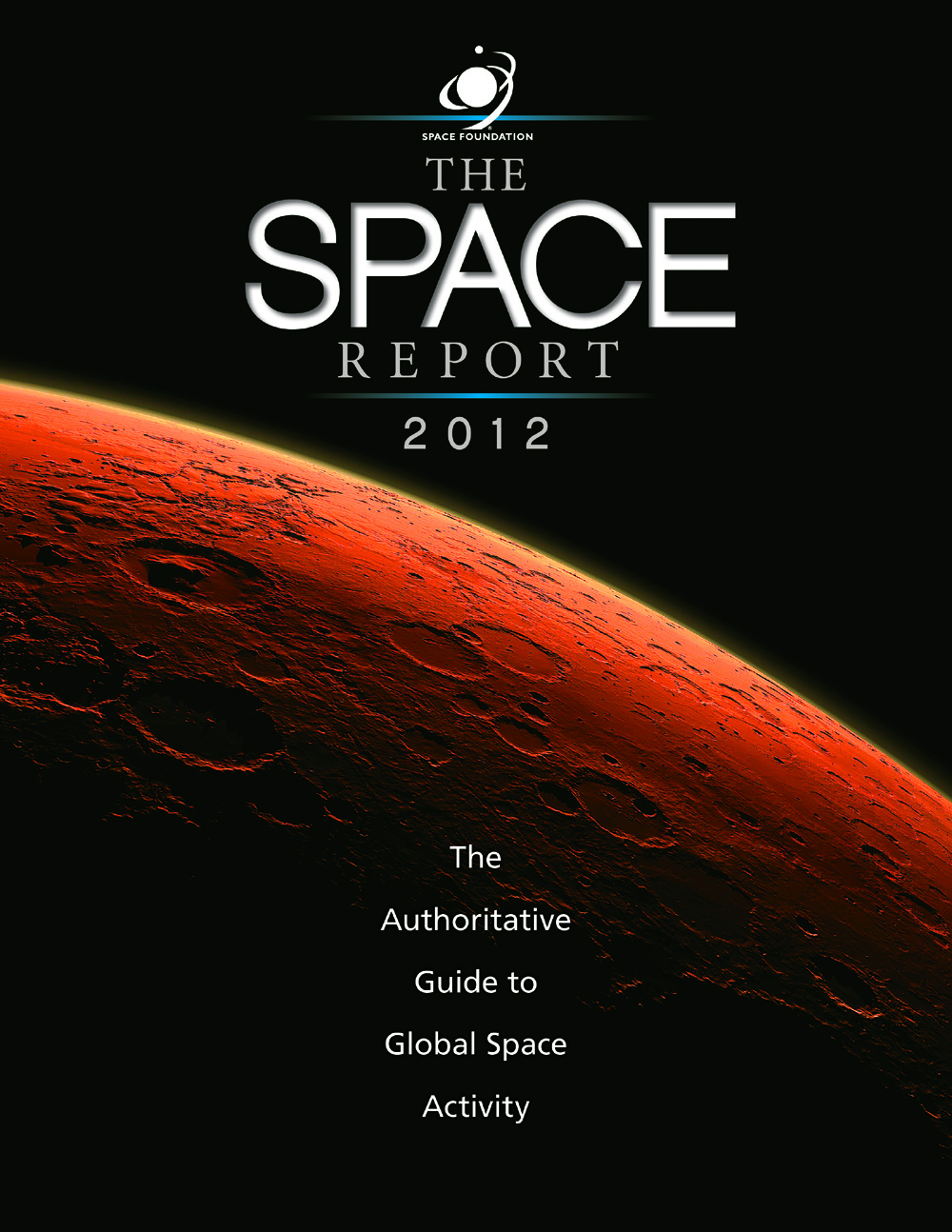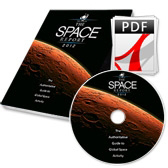Report from Headquarters
Space Economy Demonstrated its Value As a Creator of Revenue and Jobs in 2011
Written by: developer
 Published by the Space Foundation and just released in April, The Space Report 2012: The Authoritative Guide to Global Space Activity is the definitive annual overview of the global space industry and serves as a valuable resource for government and business leaders, educators, financial analysts, students and space-related businesses.
Published by the Space Foundation and just released in April, The Space Report 2012: The Authoritative Guide to Global Space Activity is the definitive annual overview of the global space industry and serves as a valuable resource for government and business leaders, educators, financial analysts, students and space-related businesses.
The book details how the global space economy grew to $289.77 billion in 2011, reflecting a surprisingly robust single-year expansion of 12.2 percent and five-year growth of 41 percent* in a global economy that has been suppressed in many other sectors.
At a time when there is much discussion surrounding the economic health of various countries, there is at least one sector that continues to expand around the world. According to The Space Report 2012, the space economy demonstrated its value yet again as a creator of revenue and jobs in 2011.
The global space economy increased in size for the sixth year in a row, growing at a faster rate than in previous years, likely due to improving conditions in some sectors of the broader global economy. The space economy grew by 12 percent in 2011, reaching an estimated total of $289.77 billion. As in past years, the majority of this growth resulted from commercial success rather than increases in government spending.
The space economy’s strength was evident as commercial infrastructure and support industries grew at an impressive rate of 22 percent in 2011, reaching a total of $106.46 billion. The vast majority of the nearly $19 billion increase is attributable to growth in ground stations and equipment, including personal navigation devices and chipsets, which added more than $18 billion in value during the year. Commercial space products and services remain the largest part of the space economy, growing to $110.53 billion in 2011, 9 percent more than in 2010. Most of the nearly $9 billion increase occurred in the direct-to-home (DTH) broadcasting sector, which added more than $7 billion in value.
The commercial space transportation services sector, consisting of companies such as Space Adventures and Virgin Galactic, remained relatively static in terms of revenue because no commercial human spaceflights occurred in 2011, although companies continued to collect deposits for future flights. A number of flight tests are scheduled to occur in 2012, indicating the possibility of growth in the near future as new services begin to carry passengers into space.cent in 2011, reaching a total of $106.46 billion. The vast majority of the nearly $19 billion increase is attributable to growth in ground stations and equipment, including personal navigation devices and chipsets, which added more than $18 billion in value during the year. Commercial space products and services remain the largest part of the space economy, growing to $110.53 billion in 2011, 9 percent more than in 2010. Most of the nearly $9 billion increase occurred in the direct-to-home (DTH) broadcasting sector, which added more than $7 billion in value.
Globally, government spending on space increased even though its percentage of the overall space economy declined to 25 percent in 2011 from 27 percent in 2010. The aggregate growth rate for government space budgets was 6 percent, bringing spending to $72.77 billion in 2011. The governments of Brazil, India and Russia all increased their space budgets by more than 20 percent. Some space agencies experienced more modest growth, as was the case for the European Space Agency (ESA), whose budget increased by 7 percent in spite of the ongoing fiscal problems in some of its member states. Space agencies in other nations, such as the United States and Japan, operated under flat or diminished budgets. Spending in the United States on government space projects was $47.25 billion in 2011, a decline of less than 1 percent from the amount spent in 2010.
The Space Foundation Indexes, which measure the performance of space-related companies on U.S. stock exchanges, demonstrated investor confidence in the health of the industry. In a year notable for its market swings, the Space Foundation Indexes grew at rates of 4 to 7 percent in 2011, outperforming both the NASDAQ and the S&P 500. The number of mergers and acquisitions in the space sector grew by 14 percent in 2011 and the median value of deals increased by 60 percent. Most of these transactions were funded by cash reserves and other assets, as companies and investors decided to use their strong financial position to add to their business portfolios, positioning themselves for future growth.
 How to Purchase The Space Report 2012
How to Purchase The Space Report 2012
The Space Report 2012 is available in print, on CD-ROM or as a downloadable PDF online at www.TheSpaceReport.org. Multi-user licenses for schools and businesses are available. The book is a “green” publication; the materials used in the processes for printing The Space Report 2012 have been certified as meeting the standards and requirements of the Forest Stewardship Council (FSC).
* Note: The 12.2 percent increase is calculated on a 2010 total of $258.21 billion, which has been adjusted from The Space Report 2011. Updates and methodology changes include addition of EUMETSAT, Kazakhstan and Ukraine budget data; and inclusion of NRO and NGA budgets in the DOD budget estimate.
This article is part of Space Watch: May 2012 (Volume: 11, Issue: 5).
